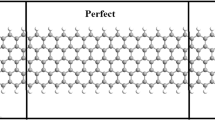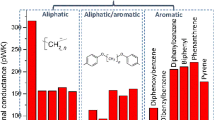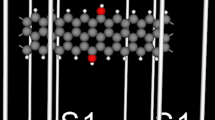Abstract
It has been reported that N and B doping induce a quasi-bound state that suppresses the conduction in graphene nanoribbon (GNR)-based junctions, while an H defect or a pyridine-like N-atom (PN) substitution at the edge of the GNR does not affect the transmission close to the Fermi energy. However, these results may vary when the size of the functional unit of the GNR junction decreases to a molecular level. In this study, a defect is introduced to a test-bed architecture consisting of a polyacene bridging two zigzag GNR electrodes, which changes the molecular state alignment and coupling to the electrode states, and varies the equivalence between two eigen-channels at the Fermi level. It is revealed that B and N atom substitution, and H defects play a dual role in the molecular conductance, whereas the PN substitution acts as an ineffective dopant. The results obtained from density functional theory combined with the non-equilibrium Green’s function method aid in determining the optimal design for the GNR-based ultra-small molecular devices via defect engineering.

Similar content being viewed by others
References
Fukata, N. Impurity doping in silicon nanowires. Adv. Mater. 2009, 21, 2829–2832.
Pierre, M.; Wacquez, R.; Jeh, X.; Sanquer, M.; Vinet, M.; Cueto, O. Single-donor ionization energies in a nanoscale CMOS channel. Nat. Nanotechnol. 2010, 5, 133–137.
Kepenekian, M.; Robles, R.; Joachim, C.; Lorente, N. Surface-state engineering for interconnects on H-passivated Si(100). Nano Lett. 2013, 13, 1192–1195.
Jelínek, P.; Švec, M.; Pou, P.; Perez, R.; Cháb, V. Tip-induced reduction of the resonant tunneling current on semiconductor surfaces. Phys. Rev. Lett. 2008, 101, 176101.
Dou, K. P.; Fan, W.; Niehaus, T. A.; Frauenheim, T.; Wang, C. L.; Zhang, X. H.; Zhang, R. Q. Electron transport suppression from tip-π state interaction on Si(100)-2×1 surfaces. J. Chem. Theory Comput. 2011, 7, 707–712.
Choi, H. J.; Ihm, J.; Louie, S. G.; Cohen, M. L. Defects, quasibound states, and quantum conductance in metallic carbon nanotubes. Phys. Rev. Lett. 2000, 84, 2917–2920.
Yang, S. H.; Shin, W. H.; Kang, J. K. The nature of graphite- and pyridinelike nitrogen configurations in carbon nitride nanotubes: Dependence on diameter and helicity. Small 2008, 4, 437–441.
Yu, S. S.; Zheng, W. T. Effect of N/B doping on the electronic and field emission properties for carbon nanotubes, carbon nanocones, and graphene nanoribbons. Nanoscale 2010, 2, 1069–1082.
Martins, T. B.; Miwa, R. H.; da Silva, A. J. R.; Fazzio, A. Electronic and transport properties of boron-doped graphene nanoribbons. Phys. Rev. Lett. 2007, 98, 196803.
Biel, B.; Blase, X.; Triozon, F.; Roche, S. Anomalous doping effects on charge transport in graphene nanoribbons. Phys. Rev. Lett. 2009, 102, 096803.
Yu, S. S.; Zheng, W. T.; Wen, Q. B.; Jiang, Q. First principle calculations of the electronic properties of nitrogen-doped carbon nanoribbons with zigzag edges. Carbon 2008, 46, 537–543.
Li, Y. F.; Zhou, Z.; Shen, P. W.; Chen, Z. F. Spin gapless semiconductor-metal-half-metal properties in nitrogen-doped zigzag graphene nanoribbons. ACS Nano 2009, 3, 1952–1958.
Wang, H. B.; Maiyalagan, T.; Wang, X. Review on recent progress in nitrogen-doped graphene: Synthesis, characterization, and its potential applications. ACS Catal. 2012, 2, 781–794.
Martins, T. B.; da Silva, A. J. R.; Miwa, R. H.; Fazzio, A. σ- and π-defects at graphene nanoribbon edges: Building spin filters. Nano Lett. 2008, 8, 2293–2298.
Datta, S. Electronic Transport in Mesoscopic Systems; Cambridge University Press: New York, 1995.
Nitzan, A. Electron transmission through molecules and molecular interfaces. Ann. Rev. Phys. Chem. 2001, 52, 681–750.
Visontai, D.; Grace, I. M.; Lambert, C. J. Electron transport through ribbonlike molecular wires calculated using densityfunctional theory and Green’s function formalism. Phys. Rev. B 2010, 81, 035409.
Larade, B. J.; Taylor, J.; Zheng, Q. R.; Mehrez, H.; Pomorski, P.; Guo, H. Renormalized molecular levels in a Sc3N@C80 molecular electronic device. Phys. Rev. B 2001, 64, 195402.
Paulsson, M.; Brandbyge, M. Transmission eigenchannels from nonequilibrium Green’s functions. Phys. Rev. B 2007, 76, 115117.
Cai, J. M.; Ruffieux, P.; Jaafar, R.; Bieri, M.; Braun, T.; Blankenburg, S.; Muoth, M.; Seitsonen, A. P.; Saleh, M.; Feng, X. L. et al. Atomically precise bottom-up fabrication of graphene nanoribbons. Nature 2010, 466, 470–473.
Datta, S. S.; Strachan, D. R.; Khamis, S. M.; Johnson, A. T. C. Crystallographic etching of few-layer graphene. Nano Lett. 2008, 8, 1912–1915.
Zhang, L. M.; Diao, S.; Nie, Y. F.; Yan, K.; Liu, N.; Dai, B. Y.; Xie, Q.; Reina, A.; Kong, J.; Liu, Z. F. Photocatalytic patterning and modification of graphene. J. Am. Chem. Soc. 2011, 133, 2706–2713.
Martínez-Galera, A. J.; Brihuega, I.; Gutiérrez-Rubio, A.; Stauber, T.; Gómez-Rodríguez, J. M. Towards scalable nano-engineering of graphene. Sci. Rep. 2014, 4, 7314.
Tapasztó, L.; Dobrik, G.; Lambin, P.; Biró, L. P. Tailoring the atomic structure of graphene nanoribbons by scanning tunnelling microscope lithography. Nat. Nanotechnol. 2008, 3, 397–401.
Merino, P.; Švec, M.; Martinez, J. I.; Jelinek, P.; Lacovig, P.; Dalmiglio, M.; Lizzit, S.; Soukiassian, P.; Cernicharo, J.; Martin-Gago, J. A. Graphene etching on SiC grains as a path to interstellar polycyclic aromatic hydrocarbons formation. Nat. Commun. 2014, 5, 3054.
Chen, Y.-C.; Cao, T.; Chen, C.; Pedramrazi, Z.; Haberer, D.; de Oteyza, D. G.; Fischer, F. R.; Louie, S. G.; Crommie, M. F. Molecular bandgap engineering of bottom-up synthesized graphene nanoribbon heterojunctions. Nat. Nanotechnol. 2015, 10, 156–160.
Wang, H. T.; Wang, Q. X.; Cheng, Y. C.; Li, K.; Yao, Y. B.; Zhang, Q.; Dong, C. Z.; Wang, P.; Schwingenschlög, U.; Yang, W. et al. Doping monolayer graphene with single atom substitutions. Nano Lett. 2012, 12, 141–144.
Guo, B. D.; Liu, Q.; Chen, E. D.; Zhu, H. W.; Fang, L.; Gong, J. R. Controllable N-doping of graphene. Nano Lett. 2010, 10, 4975–4980.
Balog, R.; Jørgensen, B.; Nilsson, L.; Andersen, M.; Rienks, E.; Bianchi, M.; Fanetti, M.; Lægsgaard, E.; Baraldi, A.; Lizzit, S. et al. Bandgap opening in graphene induced by patterned hydrogen adsorption. Nat. Mater. 2010, 9, 315–319.
Baringhaus, J.; Ruan, M.; Edler, F.; Tejeda, A.; Sicot, M.; Taleb-Ibrahimi, A.; Li, A. P.; Jiang, Z. G.; Conrad, E. H.; Berger, C. et al. Exceptional ballistic transport in epitaxial graphene nanoribbons. Nature 2014, 506, 349–354.
Lee, S.-K.; Jang, H. Y.; Jang, S.; Choi, E.; Hong, B. H.; Lee, J. C.; Park, S. H.; Ahn, J.-H. All graphene-based thin film transistors on flexible plastic substrates. Nano Lett. 2012, 12, 3472–3476.
Sun, D.-M.; Timmermans, M. Y.; Kaskela, A.; Nasibulin, A. G.; Kishimoto, S.; Mizutani, T.; Kauppinen, E. I.; Ohno, Y. Mouldable all-carbon integrated circuits. Nat. Commun. 2013, 4, 2302.
Qi, J. S.; Huang, J. Y.; Feng, J.; Shi, D. N.; Li, J. The possibility of chemically inert, graphene-based all-carbon electronic devices with 0.8 eV gap. ACS Nano 2011, 5, 3475–3482.
Chen, W.; Yu, Y. Y.; Zheng, X. M.; Qin, S. Q.; Wang, F.; Fang, J. Y.; Wang, G.; Wang, C. C.; Wang, L.; Peng, G. et al. All-carbon based graphene field effect transistor with graphitic electrodes fabricated by e-beam direct writing on PMMA. Sci. Rep. 2015, 5, 12198.
Solomon, G. C.; Andrews, D. Q.; Van Duyne, R. P.; Ratner, M. A. When things are not as they seem: Quantum interference turns molecular electron transfer “rules” upside down. J. Am. Chem. Soc. 2008, 130, 7788–7789.
Reuter, M. G.; Seideman, T.; Ratner, M. A. Molecular conduction through adlayers: Cooperative effects can help or hamper electron transport. Nano Lett. 2011, 11, 4693–4696.
Soler, J. M.; Artacho, E.; Gale, J. D.; García, A.; Junquera, J.; Ordejón, P.; Sánchez-Portal, D. The SIESTA method for ab initio order-N materials simulation. J. Phys.: Condens. Matter 2002, 14, 2745–2779.
Perdew, J. P.; Zunger, A. Self-interaction correction to density-functional approximations for many-electron systems. Phys. Rev. B 1981, 23, 5048–5079.
Brandbyge, M.; Mozos, J.-L.; Ordejón, P.; Taylor, J.; Stokbro, K. Density-functional method for nonequilibrium electron transport. Phys. Rev. B 2002, 65, 165401.
Author information
Authors and Affiliations
Corresponding author
Electronic supplementary material
Rights and permissions
About this article
Cite this article
Dou, K., Fu, X., De Sarkar, A. et al. Dual response of graphene-based ultra-small molecular junctions to defect engineering. Nano Res. 9, 1480–1488 (2016). https://doi.org/10.1007/s12274-016-1044-7
Received:
Revised:
Accepted:
Published:
Issue Date:
DOI: https://doi.org/10.1007/s12274-016-1044-7




